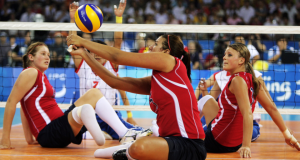Sitting volleyball (sometimes known as paralympic volleyball) is a form of volleyball for disabled athletes. In sitting volleyball, a 0.8 meter-wide net is set at 1.15 meters high for men and 1.05 meters high for women. The court is 10 x 6 meters with a 2-meter attack line. Players must have at least one buttock in contact with the floor whenever they make contact with the ball. It is also possible to block the serve and jousts are generally replayed.
Read More »Serve’s Up in NCAA Volleyball
Volleyball is a team sport in which two teams of six players are separated by a net. Each team tries to score points by grounding a ball on the other team’s court under organized rules. The NCAA has rules about the balls used in Women’s Volleyball. According to the NCAA Rules and Interpretation Handbook, Rule 3 sets the standard.
Read More »Olympic Beach Volleyballs Are Bright
The 2007/2008 Official Beach Volleyball Rules determined by the Federation Internationale de Volleyball (FIVB) dictate that the balls be spherical, flexible and uniform within a match. At 66 to 68 cm in circumference and appearing in bright colors, the balls are made of materials that do not absorb humidity.
Read More »High School Volleyballs Governed by NFHS
The National Federation of State High School Associations (NFHS) has a committee that writes the rules for many high school matches. The physical specifications of an NFHS ball are very similar to those of an NCAA ball, with the circumference being the only difference. While any NCAA ball could be used in a NFHS game (if the NFHS authentication markings appear), the reverse may not be true, depending on the actual circumference of the ball.
Read More » Balls.com – Index of Balls used in Sporting Games and Events Sports balls specifications and rules. All levels of organized play.
Balls.com – Index of Balls used in Sporting Games and Events Sports balls specifications and rules. All levels of organized play.



